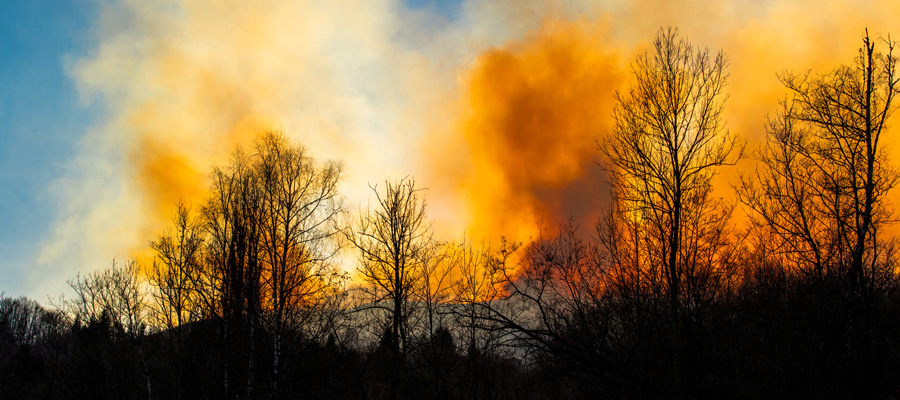A burning issue: As greenhouse gas emissions from forest fires grow, Ottawa has role to play in restoration

As one of the largest and the most extensively forested countries in the world, Canada faces unique challenges in tackling climate change.
Wildfires are burning more forests than ever as temperature and precipitation patterns change. In the process, millions of tonnes of carbon are released, pushing global greenhouse gas emissions higher.
As a signatory to the Paris Agreement on climate change, Canada formally committed to reduce its greenhouse gas emissions by 30 per cent from 2005 levels by 2030.
Reaching that goal will be a big challenge. It would be even more so if Canada, like many other countries, included the emissions from wildfires and other forest disturbances in its greenhouse gas emissions tallies.
But choosing not to count such emissions doesn’t negate them. They are real. They are rising. And they are a threat to the international agreement to which Canada is a signatory.
This creates obvious challenges. As Canada’s Council of Forest Ministers notes, provincial and territorial governments are responsible for managing natural resources: “They have exclusive powers to develop and enforce their legislation, standards and programs to ensure the development, conservation and management of forest resources.”
The federal government’s role is limited to Canada’s formidable international trade in forest products, forests on federal lands and national parks, and Indigenous Affairs as it relates to forests particularly on reserve lands. This leaves seemingly little room for Ottawa to move on broader forest carbon emissions.
But history says otherwise.
In the mid-1980s,Ottawa put up hundreds of millions of dollars in federal funds—matched by participating provinces—to assist in reforestation efforts.
In the mid-1980s, the federal government entered into cost-shared agreements with some provinces that helped to reduce a significant backlog of poorly reforested lands that had failed to sufficiently recover after they were logged, burned, or overrun by pests and disease outbreaks.
Ottawa put up hundreds of millions of dollars in federal funds to assist in reforestation efforts. The funds were matched by participating provinces, and restoring denuded forestlands began under new Forest Resources Development Agreements. The vast bulk of this money went directly to planting trees, with smaller amounts spent on tree-tending.
In British Columbia, in the ten years ending in 1997/98, half-a-billion dollars in cost-shared investments reduced that backlog by roughly 62 per cent, from a historic high of nearly two million hectares of insufficiently forested lands down to roughly 750,000 hectares.
But the irony is that 20 years on much of that good work has been undone by wildfires and other events. For example, by midsummer last year, 888 fires burned in Ontario—a 70 per cent increase in fire intensity compared to the 10-year average.
If money is to be spent again—and a new backlog of heavily burned and denuded forests across Canada suggests it should—a more thoughtful restoration effort is needed. A simple boots-on-the-ground, shovels-in-the-dirt, seedlings-in-the-earth approach will not suffice.
Ecologists and wildfire experts alike know that things can be done to make our forests both more resilient and less likely to succumb to catastrophic wildfires. Planting or allowing more hardwood trees to naturally reseed can create firebreaks. Purposely burning areas of forest to break up landscapes into patchwork quilts can reduce the risk of large-scale fires. Judiciously thinning forests by cutting down a percentage of trees on “perimeter lands” while leaving the rest of the trees standing with more airspace between them can slow down catastrophic fires as well as protect communities and local drinking water sources. And planting a greater diversity of trees can reduce the risk of widespread, devastating tree losses due to insect attacks and disease outbreaks.
A more thoughtful restoration effort is needed. Things can be done to make our forests more resilient and less likely to succumb to catastrophic wildfires.
Another thing to consider is that many emissions from Canadian forests are attributed to “slash burning,” where forest companies deliberately burn the waste wood littering the ground after logging. These emissions are significant enough that in British Columbia, the Environment Minister is mandated to extend the Province’s carbon tax to such operations.
This provides an opening for the federal government to work with provinces that agree to impose such a tax to match the funds raised, provided the pooled funds go to improving the overall health and climate resiliency of our nation’s forests.
Wise public policy dictates that we tax forest carbon emissions where appropriate and then reinvest those funds in restoring our forests, which in Canada are almost entirely publicly owned.
The current climate crisis provides all the justification Canada needs to do so.
—
This piece was originally published in The Hill Times.
Topics: Climate change & energy policy, Environment, resources & sustainability

